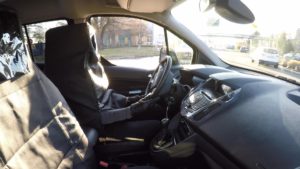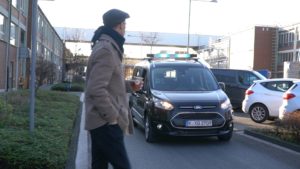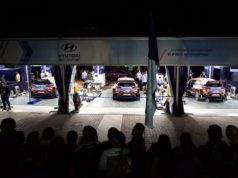Hand gestures, head nods and thumbs-up signals all help to ensure drivers, pedestrians and cyclists know what each other is doing. But how will self-driving vehicles, with no human driver, communicate with those around them? Ford has been testing one approach that uses lights to indicate what the vehicle is doing and what it will do next. That is a part of research into a special communication interface. It will help autonomous vehicles seamlessly integrate with other road users.
The company created the ‘Human Car Seat’ to ensure testing was as realistic and natural as possible. It was inside a Transit Connect van. The special design made it look like an autonomous vehicle, with the driver hidden in the seat. Observers could more effectively gauge responses to a roof-mounted light bar that flashed white, purple and turquoise to indicate when the van was driving, about to pull forwards and giving way.
“Fundamentally, people need to trust autonomous vehicles and developing one universal visual means of communication is a key to that. Turning someone into a ‘Human Car Seat’ was one of those ideas when there was a bit of a pause and then the realisation that this was absolutely the best and most effective way of finding out what we needed to know,” said Thorsten Warwel, Ford of Europe core lighting manager.

The latest testing, which complements research already carried out in the U.S., was conducted together with Chemnitz University of Technology, in Germany
Researchers expanded the tests to check the effectiveness of two other colours, in addition to white; a rooftop location, when the U.S tests had the lights placed on the top part of the windshield; and situations with further distance, showing the lights up to 500 metres away.
The conclusion: 60 per cent of the people who saw the Transit Connect thought it was an autonomous vehicle. 173 people participated in the survey. Together with the observed reactions of a further 1,600 people, turquoise was the preferred colour. Turquoise is more noticeable than white and less easily confused with red than purple. There was also a high level of acceptance and trust in the signals. All that provides a basis from which researchers can further develop the visual language.
“Making eye contact is important – but our study showed that first and foremost road users look to see what a vehicle is doing. The next step is to look at how we can ensure the light signals are made clearer and more intuitive,” said Dr Matthias Beggiato, Department of Psychology, at the university.
Trained ‘Human Car Seat’ drivers kept their eyes on the road through a false headrest. They also operated a special lever to indicate. An assistant, hidden in the back, also monitored the road as back-up.

In separate tests conducted by Ford together with the automotive lighting and electronics specialist HELLA, researchers tested further locations for the lights
Such as on the grille and headlamps, though no clear preference emerged.
Ford’s goal is developing a purpose-built self-driving vehicle for deployment first in North America in 2021. The company is working towards ensuring that people trust autonomous vehicles. Essential to this is the creation of an industry standard for communicating driving intent. The company is collaborating with several industry organisations. These include the International Organisation for Standardisation and the Society of Automotive Engineers. It is also calling on other automotive and technology companies to help create the required standard.
Ford, in partnership with Argo AI, recently became the first company to test autonomous vehicles in Washington D.C. Testing already underwent in Detroit, Pittsburgh and Miami. In China, the company is part of the Apollo program on offer by Baidu, China’s top search engine operator. Ford is also working with them to begin testing self-driving cars on designated roads in Beijing and other Chinese cities later this year.































